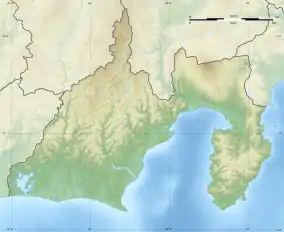 | |
| UTC time | 1930-11-25 19:02:53 |
|---|---|
| ISC event | 907761 |
| USGS-ANSS | ComCat |
| Local date | November 26, 1930 |
| Local time | 04:02 |
| Magnitude | Ms 7.3 |
| Depth | 19 km (12 mi) |
| Epicenter | 35°00′N 139°00′E / 35.00°N 139.00°E |
| Areas affected | Japan |
| Casualties | 272 killed |
The 1930 North Izu earthquake (1930年北伊豆地震, Sen-kyūhyaku-sanjū-nen Kita-Izu Jishin) occurred on November 26 at 04:02 local time.[1] The epicenter was located in the northern Izu Peninsula, Japan. It had a magnitude of Ms 7.3, and was caused by the movement of the Tanna Fault (丹那断層).
Geology
The Izu Peninsula is located in the northern tip of the Philippine Sea Plate. However, the GPS vectors of the Izu Peninsula are almost westwards, which are different from the northwestward motion of the Philippine Sea Plate. A seismically active area in the east off the Izu Peninsula might be the deformation zone between the Izu Peninsula and the main part of the Philippine Sea Plate or at times be regarded as the boundary between the Izu microplate and the Philippine Sea Plate. The suspected boundary may be a complex fracture zone than a simple boundary. In this view, the Izu microplate is pushed northwestwards by the Philippine Sea Plate and rotates clockwise, pivoting on the base of the Izu Peninsula. The rotation causes an almost westward motion under the Suruga Bay. The interplate coupling under the Sugura Bay is not weak.[2]
The Tanna Fault is part of the North Izu Fault Zone (or Kita-Izu Fault Zone) (北伊豆断層帯). The North Izu Fault Zone is about 32 kilometres (20 mi) long, lying in the NNE-SSW direction. This fault zone is predominantly of left-lateral strike-slip faulting with an estimated left-lateral slip rate of about 2 metres (6.6 ft) per 1000 years.[3] The 1930 North Izu earthquake was identified with the movement of the Tanna Fault. The focal mechanism was left-lateral strike-slip faulting.[4]
Damage
Two hundred and seventy-two people were reported dead in this earthquake. 2,165 houses were totally destroyed. Building damage rate was high along the Tanna Fault.[5] Many buildings collapsed in the village of Kawanishi (川西村), now part of Izunokuni, Shizuoka.[6] The earthquake caused many landslides.[7] A landslide caused 15 deaths in the village of Nakakano (中狩野村), and another one caused 8 deaths in the village of Kitakano (北狩野村), both locations now belong to Izu, Shizuoka.[8] The intensity reached shindo 6 in Mishima, Shizuoka.[9] Fires were reported in Itō, Shizuoka.[10]
Related earthquakes
The change of the Coulomb failure stress due to the 1923 Kantō earthquake may have had contribution to the occurrence of this earthquake.[11]
There was an earthquake swarm near Itō, Shizuoka from February 13 to the end of May, 1930, to which the November 26 earthquake was not thought to belong.[10][12][13]
The largest foreshock of this earthquake occurred on November 25, 1930, at 16:05 local time, and the largest aftershock occurred on March 7, 1931, at 01:53 local time.[13]
Earthquake light
A prominent earthquake light was observed.[14] It could be observed over a large area, including the coast of Suruga Bay, the Izu Peninsula, the coast of Sagami Bay, Sagami River Valley, the coast of Tokyo Bay, and the Bōsō Peninsula. The earthquake light was reported to have appeared before the earthquake occurred and continued for at least an hour.[15]
See also
References
- ↑ National Geophysical Data Center / World Data Service (NGDC/WDS) (1972), Significant Earthquake Database (Data Set), National Geophysical Data Center, NOAA, doi:10.7289/V5TD9V7K
- ↑ "Interplate coupling in the Tokai District, Central Japan, deduced from continuous GPS data" by T. Sagiya
- ↑ "北伊豆断層帯の長期評価について" (PDF). jishin.go.jp (in Japanese). Archived (PDF) from the original on 2021-01-28.
- ↑ "丹那断層ガイド". sk01.ed.shizuoka.ac.jp. Archived from the original on 2012-04-21. Retrieved 2012-06-01.
- ↑ "北伊豆地震(9) 断層沿い、高い倒壊率 | 静岡新聞". Archived from the original on 2013-01-18. Retrieved 2012-06-02.
- ↑ "北伊豆地震(1) M7.3、前兆に研究者が注目 | 静岡新聞". Archived from the original on 2013-01-17. Retrieved 2012-06-02.
- ↑ "静岡県に被害をもたらした主な地震と日本で近年おきた主な地震". Archived from the original on 2011-06-09. Retrieved 2012-06-01.
- ↑ "北伊豆地震(10) 脆弱な地盤、山崩れが多発 | 静岡新聞". Archived from the original on 2013-01-17. Retrieved 2012-06-02.
- ↑ "静岡県地震防災センター/三島市". Archived from the original on 2011-07-07. Retrieved 2012-06-02.
- 1 2 "静岡県地震防災センター/伊東市". Archived from the original on 2011-06-09. Retrieved 2012-06-03.
- ↑ "Archived copy" (PDF). Archived from the original (PDF) on 2017-08-10. Retrieved 2012-06-01.
{{cite web}}: CS1 maint: archived copy as title (link) - ↑ Sasai, Y.; Ishikawa, Y. (1997), "Seismomagnetic models for earthquakes in the eastern part of Izu Peninsula, Central Japan", Annals of Geophysics, 40 (2): 463–478, doi:10.4401/ag-3927 (inactive 2023-08-01)
{{citation}}: CS1 maint: DOI inactive as of August 2023 (link) - 1 2 Utsu, Tokuji (31 August 1981). Seismicity of the Izu Peninsula and Its Vicinity from 1901 through 1980 with Some Remarks on the Characteristics of Foreshock Activities (PDF) (Thesis). The University of Tokyo. hdl:2261/12794. Archived from the original (PDF) on 2016-03-04. Retrieved 2012-06-02.
- ↑ http://www.seis.nagoya-u.ac.jp/EVENT/program_WS.pdf%5B%5D
- ↑ 武者, 金吉 (22 June 1931). 昭和五年十一月廿六日伊豆地震に伴ひたる光の現象に就て (Thesis). The University of Tokyo. hdl:2261/9991.
External links
- The International Seismological Centre has a bibliography and/or authoritative data for this event.